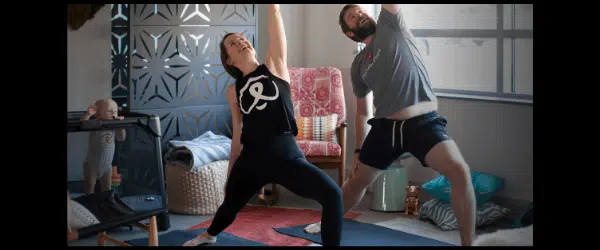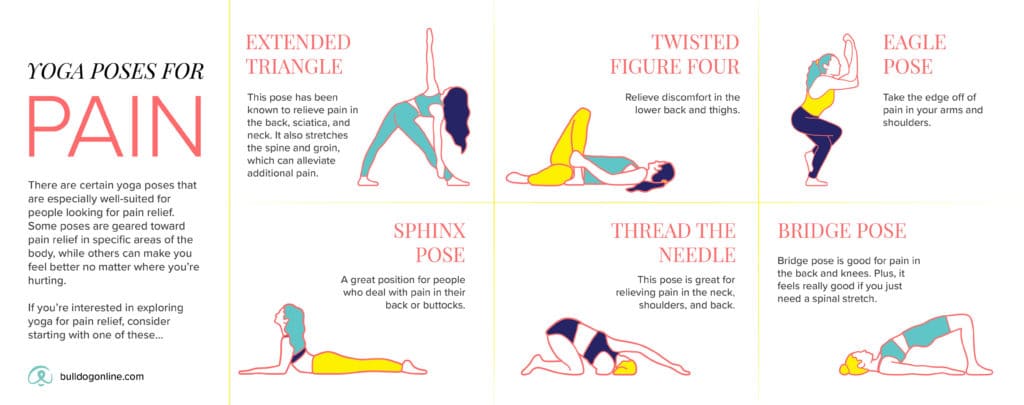Pain can cause your quality of life to worsen. Yoga can help your chronic pain while improving your physical & mental health.
You may associate many physical activities and exercises with causing pain. If you’ve ever experienced soreness after a workout, you know exactly what we’re talking about here.
But that’s not the case with all physical activities. Yoga, for one, actually has the ability to ease pain. While some yoga classes — specifically power yoga — emphasize getting your heart rate up, others will give you the opportunity to focus on areas of the body that typically give you trouble. This can help you relieve those pains!
This guide to yoga for pain will tell you everything you need to know about how yoga can be integrated into a larger plan to reduce your pain.
Table of Contents:
How Does Yoga Help With Pain Management?
Should I Do Yoga If I’m Injured?
Types of Yoga for Different Types of Pain
Our easy-to-follow yoga classes are FREE for 14 days!
Just what the doctor ordered 😉
Understanding Pain
Yoga can become part of a treatment program for all kinds of aches and pains! A meta-study from Harvard Health of 1,600 participants determined that yoga can improve daily function for people who deal with chronic pain as part of other physical conditions. Much of yoga’s pain relief benefits are rooted in the way the practice connects the mind and body… but we’ll get to that later.
When to Seek Medical Help
To be clear — if you struggle with chronic pain, it’s always best to check in with a medical professional before you add something new to your routine. An expert will answer any questions you may have and can recommend movements that you might want to focus on or avoid given your particular case. When in doubt, ask someone you trust!
In the meantime, this guide to yoga for pain will give you a better idea of how yoga has been scientifically proven to take the edge off of physical discomfort and how you might be able to integrate it into your life. Our goal? To help you feel less pain.
How Does Yoga Help With Pain Management?
Pain is a complicated thing, and as all too many people have experienced firsthand, the business of easing that pain can feel just as complex. If you are interested in exploring yoga as a possible treatment for your pain, there is plenty of science to support the fascinating ways in which the two are connected. There are also plenty of people out there in the world who can tell you about their personal experience with yoga for pain relief!
There are several reasons that yoga has been proven to support pain management. Check it out…
Reduces Inflammation
Inflammation in the body is a common cause of pain. People who experience chronic inflammation in a particular muscle likely experience chronic pain in the same muscle. Inflammation is also associated with autoimmune disorders and other chronic physical disorders. Yoga’s ability to fight or reduce inflammation makes it well-suited for pain management.
A 2015 study published in the Journal of Clinical and Diagnostic Research focused on the effect of a regular yoga practice on levels of inflammation. Of the 218 participants in the study, half practiced yoga for roughly one hour per day for more than five years. They also participated in other moderate and strenuous exercises. The other half of the participants did not include yoga as part of their wellness regimens. Inflammation in the body was lower in the group who did participate in yoga.
Changes Pain Perception
As you might expect if you’ve experienced it, chronic pain can actually impact the brain. Yeah — it’s really crummy. According to Psychology Today, pain alters brain structure. The changes it causes to the gray and white matters in our brains have been linked to depression, anxiety, and decreased cognitive function.
But here’s something cool: yoga has the opposite effect!
Studies have shown that moving your body on the mat counteracts those changes in the brain so that you actually perceive pain less.
Increases Flexibility
A lack of flexibility is often the root of pain in certain muscle groups. University of Iowa Health Care notes that improving flexibility and range of motion can reduce pain levels, especially in the back. This is the same logic that’s led many of us to understand basic stretching as a treatment for soreness.
While yoga isn’t just stretching — common misconception! — it does integrate plenty of stretching movements that go a long way toward increasing flexibility for practitioners. Harvard Health describes a study in which a small group of participants who were new to yoga got on the mat twice a week for a total of three hours. At the end of eight weeks, the participants were more flexible. Studies like this are promising in the conversation about yoga and pain relief!
Helps Prevent Injury
Sustaining an injury can affect pain in multiple ways. Most obviously, perhaps, injury can trigger pain in the first place, causing you physical soreness or discomfort that you’ve never experienced before. Injuries can also trigger pre-existing issues in the body that cause pain. As a rule, avoiding injury is a good way to minimize the pain you feel! It sounds like a no-brainer, but it’s worth spelling it out.
Because of the way that yoga improves flexibility and range of motion, it can help prevent falls. Many yoga poses help practitioners improve their balance, which also minimizes falls. Integrating yoga into your routine can minimize your risk of accidents, thereby avoiding additional pain in the future.
The other cool thing about yoga is that if you do sustain an injury, yoga can act as a form of active recovery so you can continue moving your body while still being gentle with yourself. There are many ways to modify standard yoga poses so that they’re accessible after injury. And more yoga means less chance of another injury down the road! It’s a really great positive cycle.
Yoga and Mindfulness
Once you’re already dealing with pain, it’s helpful to have some coping mechanism on hand to make things a little more comfortable. Yoga can come in here, as well!
According to Healthline, yoga has been proven to decrease stress and anxiety, both of which can be caused by chronic pain. If your pain is messing with your mental health, you might want to give yoga a try. It will help you quiet your mind and tune in with your body more calmly.
Experience the mind & body benefits of yoga today 🙌
No joke, tell everyone you know!
Should I Do Yoga If I’m Injured?
As we mentioned above, yoga can be used as a form of active recovery for certain types of injuries. Per The Physio Company, active recovery is “when a person uses non-strenuous physical activity to stay nimble and keep their bodily fluids, such as blood and lymph, flowing.” And while some types of yoga could absolutely be described as strenuous, there are several styles that could easily fall in the “non-strenuous” category. We’ll fill you in on those in a second.
It’s also important to reiterate that if you are considering practicing yoga while you’re injured, you should check in with a medical professional first. A doctor or other expert will be able to examine you, review your specific case, and let you know of any significant risks. They might also be able to suggest precautions to reduce the risk of aggravating your existing injury.
Generally speaking, if you’re getting on the mat while injured, it’s important to move slowly and to be very deliberate about each position. Pay attention to each and every movement. If your class instructor offers modifications to make poses less strenuous, take them! Now is not the time to be a hero. Perhaps most importantly, listen to your body! If you are experiencing a lot of discomfort from a certain movement or position, stop doing it. Child’s Pose — the position in which you’re kneeling on your mat with your big toes touching each other, your knees wide, and your torso stretched out flat between your thighs — is fair game in any yoga class and is a great rest position for anyone who’s uncomfortable.
Types of Yoga for Different Types of Pain
There are certain types of yoga that are inherently slower and gentler than others. If you are practicing yoga while injured or experiencing pain, it’s best to stick to one of these types. You’ll be less likely to push yourself too hard and make your pain worse.
Each type of yoga is a little different and has something unique to offer as part of your pain regimen. Choose a type that seems best-suited for your current physical situation.
Hatha Yoga for Pain
Hatha is the type of yoga that is probably most similar to what comes to mind when you close your eyes and imagine a yoga class. According to Verywell Fit, “the practice involves breath, body, and mind” and “breathing, yoga poses, and meditation.”
Because of its slower pace and sense of intentional movement, Hatha yoga has proven beneficial for people who experience back and neck pain. Plus, it offers plenty of time and space for practitioners who need help modifying positions so they don’t aggravate pain.
Iyengar Yoga for Pain
The Iyengar Yoga National Associate of the United States notes that this type of yoga focuses on “gradual but steady progress, rather than quick and fleeting results.” Anyone who has dealt with chronic pain or who is looking for a type of exercise they can perform while injured knows that gradual is the key word there. Iyengar yoga emphasizes the body’s alignment in each pose, which is critical for anyone who is feeling a little extra protective of their bodies. It’s also extremely detail-oriented, so be prepared to be patient in an Iyengar class.
Yin Yoga for Pain
Yin yoga is considered the opposite of faster yoga practices like Ashtanga or power yoga. Per Yoga Journal, yin focuses on stretching connective tissue in the joints. Stretching connective tissue in this manner can make your muscles longer and stronger, but it can also help ease pain. Yin yoga can be especially effective for joint pain, since that’s where the stretching takes place.
Restorative Yoga for Pain
According to Healthline, “restorative yoga is a passive, meditative form of yoga that allows you to focus on your breath while releasing tension in your body.” Restorative yoga encourages practitioners to hold poses for longer periods of time than other types of yoga. You might hold positions for up to five minutes to really give your body a chance to sink in. Restorative yoga also integrates props like blocks and blankets, which gives you lots of ways to adapt your movements to accommodate your pain.
This type of yoga is considered gentle and safe enough for pretty much anyone, so it’s a good place to start a yoga practice no matter your aches and pains.
Meditative Yoga for Pain
If you’re looking for a little less movement and little more meditation, we might recommend a yoga class that focuses on the mind more than the body. (We offer online meditation classes!) Meditation classes will give you a chance to really tend to your mental health so that you are able to better cope with the physical challenges you’re experiencing.
Yoga Poses for Pain
There are also certain yoga poses that are especially well-suited for people looking for pain relief. Some poses are geared toward pain relief in specific areas of the body, while others can make you feel better no matter where you’re hurting.
If you’re interested in exploring yoga for pain relief, consider starting with one of these:
Extended Triangle
This pose has been known to relieve pain in the back, sciatica, and neck. It also stretches the spine and groin, which can alleviate additional pain.
Start with your feet four feet apart, your right foot in front. Turn your right toes to face forward. Turn your left toes out at an angle. Raise your arms so they’re parallel to the floor, with your palms facing the mat. Hinge forward at your hip and come forward with your arm and torso. Reach your right hand down to rest on your leg, a yoga block, or the floor. Your left arm should reach up toward the ceiling. Hold the pose, then repeat on the other side.
Sphinx Pose
Sphinx pose is another great position for people who deal with pain in their back or buttocks.
You should begin on your stomach, with your legs resting on your mat, reaching straight out behind you. Engage your core and thigh muscles. Move your elbows under your shoulders. Your forearms should be resting on the floor, with your palms facing down. Gently lift your head and upper body off the mat. Your lower abdominal muscles should be engaged to support your back. Do not collapse into your lower back. Keep your gaze straight ahead and hold the position.
Twisted Figure Four
Try a Twisted Figure Four to relieve discomfort in the lower back and thighs.
To do this, lie on your back with your feet on the ground and your knees bent. Rest your right ankle on your left knee, then let both legs fall to your left side. As your right knee points toward the ceiling, rest the sole of your right foot on your mat. To make the pose a bit more accessible, you can try moving your legs down a few inches. Hold, then switch to the other side.
Thread the Needle
This pose is great for relieving pain in the neck, shoulders, and back.
You’ll start on all fours. Your wrists should be under your shoulders and your knees under your hips. Lift your right hand off the mat and move it over to the left side of your mat, sliding it under your body. Keep your palm facing up. Press your left hand into the ground for support, then rest the weight of the rest of your body on your right shoulder while looking to the left. Hold, then switch to the other side.
Eagle Pose
Need to take the edge off of pain in your arms and shoulders? Eagle Pose is a great option.
While standing, raise your arms so they are perpendicular to the floor. Bend your elbows into an L-shape. Cross one elbow over the other, then begin to twist your arms around each other. You can also hug your arms together, if that’s more comfortable. Press the inside of your palms together. Once your arms are locked in place, lift your elbows upward and reach your fingers toward the ceiling. Hold, then gently switch the position of your arms to stretch the other side.
Bridge Pose
Bridge pose is good for pain in the back and knees. Plus, it feels really good if you just need a spinal stretch.
Begin by lying on your back with your knees bent and your feet hip-width apart and flat on your mat. Your upper arms should rest on the floor. Bend your elbows alongside your ribs. Press your elbows and your shoulders down into the ground. Then, lift your chest and bring your shoulder blades closer together. Press your feet down, then lift your buttocks off the floor. Lengthen your tailbone. Straighten your elbows and lace your fingers together beneath your back.
To use this pose for relief from knee pain, you also might try putting a yoga block between your upper thighs, while keeping everything else the same.
Explore these poses and more with your 14 day FREE trial!
Plus, check out our low-impact workout plan to see how yoga can help your pain ✔











